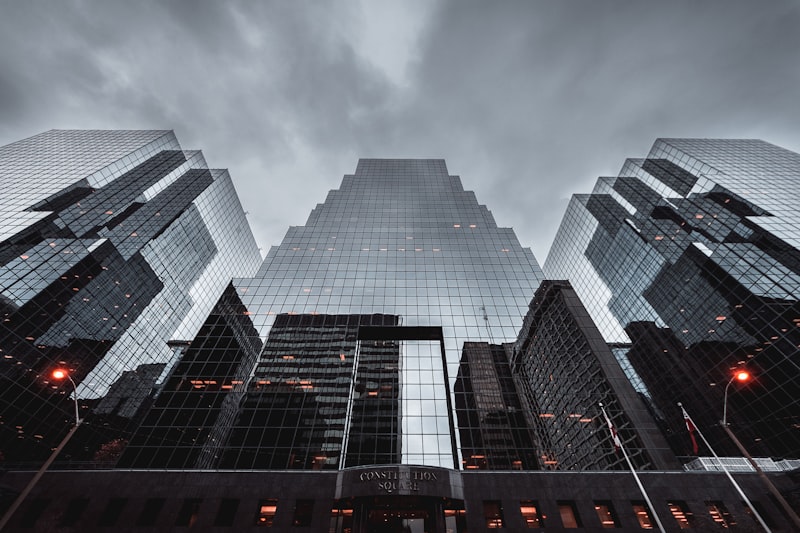In Toronto, the skyline is a testament to contemporary architecture, with structures like the CN Tower piercing the clouds and the Royal Ontario Museum showcasing avant-garde design. The city’s mix of glassy high-rises and Victorian-era buildings creates a dynamic contrast, drawing millions of visitors annually.
Heading west to Vancouver, the city’s architecture harmonizes with its stunning natural surroundings. Glass-walled skyscrapers reflect the snow-capped mountains and Pacific Ocean, while historic neighborhoods like Gastown preserve Victorian charm amidst bustling modernity.
In contrast, Quebec City transports visitors back in time with its UNESCO-listed Old Town. The city’s French colonial architecture, narrow cobblestone streets, and ornate cathedrals evoke a European ambiance unique in North America. Exploring the fortified walls of Old Quebec or the majestic Château Frontenac feels like stepping into a living history book.
Moving towards the prairies, Calgary surprises with its blend of cowboy culture and contemporary design. The Calgary Tower dominates the skyline, offering panoramic views of the city’s mix of modern skyscrapers and historic sandstone buildings. The architecture here mirrors the city’s evolution from a frontier outpost to a vibrant economic hub.
Even in smaller cities like Halifax on the East Coast, maritime influences shape the architecture. The city’s historic waterfront features a mix of Georgian, Victorian, and modern buildings, showcasing its seafaring heritage alongside bustling markets and lively pubs.
From Vancouver to Montreal: Unveiling Canada’s Architectural Marvels
Canada, a land of diverse landscapes and rich cultural tapestry, also boasts some of the most impressive architectural wonders spanning from coast to coast. Starting from the west coast in Vancouver, where modernity meets natural beauty, to the historic city of Montreal in the east, known for its blend of old-world charm and contemporary design, Canada’s architectural marvels showcase both innovation and heritage.

In Vancouver, nestled against the backdrop of snow-capped mountains and the Pacific Ocean, structures like the Vancouver Convention Centre stand out as feats of modern engineering. With its iconic design that mimics the shape of a sailing ship, it not only serves as a hub for conferences and events but also as a testament to sustainable architecture with its green roof and waterfront location.
Moving eastward, Toronto’s skyline dominates with the CN Tower, once the tallest freestanding structure in the world. Its futuristic design and panoramic views from the top attract millions of visitors annually, symbolizing Canada’s ambition and technological prowess.
Further east lies Ottawa, the capital city, where the Parliament Hill buildings stand as the political heart of the nation. The Gothic Revival style of the Centre Block, with its intricate stonework and iconic Peace Tower, symbolizes Canada’s parliamentary democracy and national unity.
In Quebec City, a UNESCO World Heritage site, the majestic Château Frontenac reigns over the cityscape. This grand hotel, resembling a medieval French château, blends seamlessly with the historic Old Town, offering visitors a glimpse into Canada’s colonial past.

Finally, in Montreal, the Biosphere stands as a symbol of environmental stewardship and architectural innovation. Originally built for Expo 67, its geodesic dome design by Buckminster Fuller remains a beacon of sustainability and scientific discovery.
Diverse Designs: The Architectural Tapestry of Canada’s Urban Centers
Toronto, often dubbed as Canada’s melting pot, showcases a blend of old and new architectural styles. The iconic CN Tower dominates the skyline, standing tall amidst a sea of glass skyscrapers that symbolize the city’s modernity and economic prowess. Yet, nestled within its downtown core are historic neighborhoods like Distillery District, where Victorian industrial architecture meets contemporary art galleries and trendy boutiques.
Moving westward, Vancouver embraces its natural surroundings with a harmonious blend of glass towers and low-rise buildings that offer stunning views of the mountains and ocean. The city’s commitment to sustainability is evident in its green building designs and innovative urban planning, making it a model for eco-friendly living in urban environments.
In contrast, Montreal captures the essence of European charm fused with North American dynamism. The UNESCO-designated Old Montreal enchants visitors with its cobblestone streets, 17th-century facades, and Gothic Revival churches such as Notre-Dame Basilica. Meanwhile, the city’s modern skyline, characterized by sleek high-rises and contemporary cultural institutions, reflects its status as a hub of arts and innovation.
In Eastern Canada, Halifax stands out with its maritime heritage reflected in its architecture. The historic waterfront blends 19th-century warehouses with modern amenities, offering a glimpse into the city’s past as a major trading hub. The Citadel, a star-shaped fortress overlooking the city, stands as a testament to Halifax’s military history and architectural prowess.
From the multicultural mosaic of Toronto to the historic charm of Quebec City, Canada’s urban centers are more than just cities—they are living museums that showcase the evolution of architectural styles over centuries. Whether you’re strolling through Vancouver’s Stanley Park or exploring Montreal’s underground city, each corner reveals a new chapter in Canada’s architectural tapestry, inviting visitors to marvel at its diversity and innovation.
Discovering Canada’s Modern Icons: Architectural Wonders Across Cities
Toronto, Canada’s largest city, stands out with the CN Tower, an engineering masterpiece soaring high above the cityscape. Originally the world’s tallest freestanding structure, it remains an enduring symbol of Canada’s ingenuity and ambition. Its glass floor observation deck offers a breathtaking view, attracting millions annually.
Moving west to Vancouver, the shimmering form of the Vancouver Convention Centre catches the eye. Designed to resemble a giant sailboat, it harmoniously integrates with the waterfront, offering stunning views of the North Shore mountains. Hosting international events, it symbolizes Vancouver’s global connectivity and commitment to sustainability.
In Montreal, the Biosphere in Parc Jean-Drapeau is an architectural gem. Originally built as the US Pavilion for Expo 67, its futuristic design resembling a giant sphere evokes a sense of environmental consciousness. Today, it houses exhibitions on climate change and sustainability, inspiring visitors to reflect on our planet’s future.
Calgary’s Bow Tower redefines the city skyline with its bold crescent shape and stunning glass facade. Designed for energy efficiency and aesthetics, it reflects Calgary’s status as a hub for business and innovation in Western Canada. Its sky gardens offer serene spaces amidst the urban hustle.
Lastly, in Ottawa, the Canadian Museum of History stands as a testament to the nation’s rich heritage. Its sweeping curves and grandeur overlook the Ottawa River, inviting visitors to explore Canada’s diverse cultural tapestry through immersive exhibits and artifacts.
A Journey Through Time: Historic and Contemporary Architecture in Canada
Imagine standing before the grandeur of Parliament Hill, where Gothic Revival architecture meets the political heartbeat of the nation. The Peace Tower, with its iconic clock and carillon, stands tall as a symbol of Canada’s unity and resilience. This historic landmark not only serves as a seat of government but also as a testament to the craftsmanship of Canadian artisans of the past.
Moving westward, the prairie skies of Saskatchewan frame the awe-inspiring sight of the RCMP Heritage Centre in Regina. Designed to resemble a prairie fire, this contemporary structure pays homage to the cultural and historical significance of the Royal Canadian Mounted Police. Its bold lines and expansive windows invite visitors to explore the rich history of law enforcement in Canada.
In contrast, the bustling cityscape of Toronto offers a glimpse into the future of Canadian architecture. The CN Tower, once the tallest freestanding structure in the world, remains an engineering marvel with its sleek design and panoramic views. Nearby, the Art Gallery of Ontario captivates with its glass and titanium façade, a striking blend of modern aesthetics and sustainable design principles.
Venturing further east, the charming streets of Old Montreal beckon with their European-inspired architecture. Cobblestone pathways lead to the Notre-Dame Basilica, a masterpiece of Gothic Revival architecture adorned with intricate wood carvings and vibrant stained glass windows. This iconic landmark continues to inspire visitors from around the globe with its timeless beauty and historical significance.
From the rugged coastlines of Newfoundland to the vibrant neighborhoods of Vancouver, Canadian architecture celebrates both tradition and innovation. Each structure, whether historic or contemporary, reflects a unique chapter in Canada’s story—a narrative shaped by its landscapes, cultures, and people. As we journey through time, let us marvel at the architectural wonders that define and unite this great nation.
Innovation in Concrete and Glass: Architectural Trends in Canadian Cities
Concrete, known for its durability and strength, has undergone a metamorphosis in recent years. Innovations in concrete mixtures have led to the development of high-performance variants that not only withstand harsh climates but also reduce environmental impact. From self-healing concrete that repairs cracks autonomously to ultra-high-performance concrete used in skyscrapers, the versatility of this material continues to astonish.
Glass, on the other hand, has transcended its role as merely a building enclosure. Today, glass is a key player in sustainable architecture. Innovations such as smart glass that adjusts transparency based on sunlight exposure and photovoltaic glass that generates electricity are revolutionizing energy efficiency in buildings across Canada. These advancements not only enhance occupant comfort but also contribute significantly to reducing carbon footprints.
The integration of concrete and glass in Canadian cities reflects a broader trend towards marrying aesthetics with functionality. Architects are increasingly using these materials to create structures that are not only visually striking but also highly efficient and sustainable. Buildings featuring expansive glass facades and innovative concrete structures are becoming landmarks, defining the urban landscape of cities like Toronto, Vancouver, and Montreal.
As we look to the future, the evolution of concrete and glass in architecture promises even more groundbreaking innovations. Whether it’s advancements in material science or breakthroughs in sustainable building practices, these developments will continue to shape the way Canadian cities grow and develop, ensuring a future where beauty meets innovation seamlessly.
Frequently Asked Questions
Which Canadian cities are known for their iconic modern architecture?
Discover Canadian cities celebrated for their iconic modern architecture. Explore the striking contemporary designs of Toronto, Vancouver, and Montreal, showcasing innovative structures that define their urban landscapes.
What are the distinguishing architectural features of Canadian cities?
Learn about the unique architectural features that define Canadian cities, from historic influences to modern innovations. Discover how diverse cultures have shaped cityscapes, blending heritage with contemporary design trends.
How has Canada’s history influenced its urban architectural style?
Explore how Canada’s historical events and cultural influences have shaped its urban architectural style, blending indigenous traditions, European colonization impacts, and modern innovations.
Where can I find examples of indigenous architecture in Canadian urban landscapes?
Discover examples of indigenous architecture in Canadian urban landscapes by exploring cultural centers, museums, and public buildings designed with indigenous influences. Look for architectural tours or exhibits focusing on indigenous design principles and modern interpretations across cities like Toronto, Vancouver, and Ottawa.
How does climate impact the architecture of cities like Vancouver and Montreal?
Discover how climate influences the architectural designs of cities such as Vancouver and Montreal. Learn about the unique building materials, energy efficiency strategies, and urban planning considerations shaped by these cities’ diverse climates.


